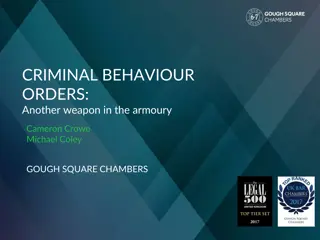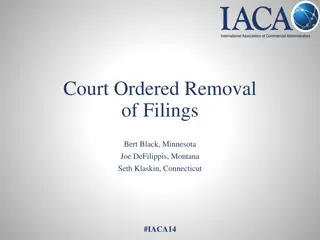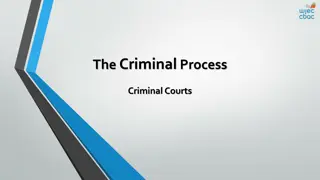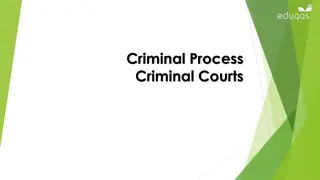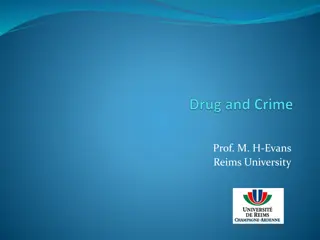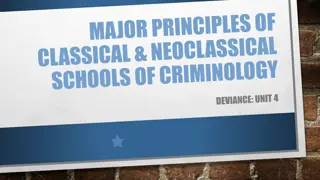Criminal Expungement Program Overview
A comprehensive overview of a criminal expungement program, including the need for expungements, working with clients, program services offered, societal impacts, and the importance of expungement in overcoming barriers to employment and housing. The program aims to help individuals with criminal records rebuild their lives by providing legal advice, representation, and support through the expungement process.
Download Presentation

Please find below an Image/Link to download the presentation.
The content on the website is provided AS IS for your information and personal use only. It may not be sold, licensed, or shared on other websites without obtaining consent from the author. Download presentation by click this link. If you encounter any issues during the download, it is possible that the publisher has removed the file from their server.
E N D
Presentation Transcript
Criminal Expungement Full Representation Training Eliza Messinger Program Manager and Resource Attorney
Roadmap Need for Expungements Working with VLN Clients Expungement Law Taking a Criminal Expungement Case Through VLN Resources and Contacts Questions
Criminal Records Graph Source: Arrest Dashboard, Minnesota Department of Public Safety Created at every interaction with the criminal justice system Most records are publicly accessible Trend towards more access to information Records do not go away
Why Criminal Expungement? Societal exclusion due to criminal history Employment: Any record, even arrest, can impact hiring decision Housing: Scarcity of affordable housing means landlords can be picky about who to rent to Exporting disparities from justice system to other areas of life Coaching, volunteering at kids school, community service, etc. Systemic racism in the criminal justice system Keeps people in poverty: "Estimated benefits of expungement outweigh costs to state government by about $5,800 per person in one year" in 2014 California study.* Expungement is the means to help people overcome these barriers despite past mistakes or lifestyles *https://news.stanford.edu/news/2014/march/criminal-record-study-032014.html
Working With VLN Clients This Photo by Unknown author is licensed under CC BY-NC-ND.
Program Services Income is 300% FPG or below (about $38,000/yr for one person) Legal Advice and case screening for further services Workshops (Attorney fills out petition, serves, and files it, but client represents themself in court) Full Representation: 200% FPG and below (about $26,000/yr for one person) Services VLN Staff provide attorneys: One-on-One support on clients, law, and process Case Screening
Working with VLN Clients Clients are reliant on our services to improve their lives Understanding your client's specific situation: Using proper pronouns, pronouncing client's name right Trauma triggers Ongoing poverty/ crises Acknowledge racism in criminal justice system/ life Understand barriers to service and work around them with client Communication Technology Transportation Childcare
Expungement Basics Minn. Stat. 609A Expungement is the sealing of criminal records NOT destruction Records can be reopened but happens rarely Expunged records can be viewed and shared among criminal justice agencies when investigating or prosecuting a crime Records can be used by law enforcement agencies against applicants for employment in the agencies
General Expungement Process Gathering information and completing a petition Preparation It can take up to a year! Serving agencies whose records may be affected Filing with courts Service and Filing Short court hearing Hearing 63 Days (Minimum) Expungement Order Up to 90 Days Expungement 60 Day Appeal Period
Types of Expungement Arrest-only records letters Statutory Expungement Minn. Stat. 609A No expunged records show up on background checks Seals court and executive branch agency records Two Processes: Court Process Traditional process Prosecutor-Led Expungement (PLEs) Inherent authority: Judge uses power over court system to seal court records Record is still on background checks but client will have court order For crimes that are excluded from statutory expungement Serious drug, theft, or violent felonies NOT for registration crimes can't ever expunge those The court process under statutory expungement and inherent authority use the same process VLN has a program which will pick the statute for you.
Statutory Expungement Bureau of Criminal Apprehension (BCA) Minnesota Court Information System (MNCIS) Police Department City Attorney Sheriff s Department County Attorney State Attorney General Department of Corrections Department of Human Services Private data-miners Private theft databases Websites
Inherent Authority Expungement Bureau of Criminal Apprehension (BCA) Minnesota Court Information System (MNCIS) Police Department City Attorney Sheriff s Department County Attorney State Attorney General Department of Corrections Department of Human Services Private data-miners Private theft databases Websites
Statutory Expungement 1- Statutes Juvenile offenses Court process only [Minn. Stat. 260B.198] If case certified and tried in adult court, use statutory expungement statute [Minn. Stat. 609A.02 Subd. 2] No waiting period for either type of case Cases that ended with a dismissal or acquittal [Minn. Stat. 609A.02 Subd. 3 (a) (1- 2)] Subd. 3(1): Resolved in favor cases No waiting period These are cases where there was NO GUILTY PLEA or facts admitted to Subd. 3(2): 1 Year crime-free wait period with no CHARGES Dismissal that is part of a plea deal that required a guilty plea, an admission of facts, completion of diversion program or stay of adjudication. Certain controlled substance offenses ending in dismissal [Minn. Stat. 609A.02 Subd. 1] First time drug offenses dismissed after diversion/ stay of adjudication under Minn. Stat. 152.18 No waiting period
Statutory Expungement 2- Statutes Convictions for petty misdemeanors, misdemeanors, or gross misdemeanors (including vacated convictions)[Minn. Stat. 609A.02 Subd. 3 (a) (3-5)] Petty Misdemeanors: 2 years after discharge Misdemeanors: 2 year conviction-free wait period Gross Misdemeanors: 4 year conviction-free wait period Only felonies listed in Minn. Stat. 609A.02 Subd. 3 (b) Approximately 50 non-violent felony convictions 5th degree drug crimes, some theft 5 year conviction-free wait period Stays of imposition: must be considered as original felony conviction level - State v. S.A.M., 891 N.W.2d 602 (Minn. 2017)
Inherent Authority No 5-year conviction-free waiting period. Once the case is closed, you can file to expunge a petition Hard to get unless longer waiting period
Case Screening Consideations beyond legal qualifications No open criminal cases: All criminal cases must be closed Petty misdemeanors aren't crimes, they are citations Fees and Fines: Judges may deny petition if money is owed to the court or not! VLN rules: try to show judges clients are paying tickets off Balancing test: Petitioner is unduly burdened by record AND rehabilitated Weighed against public's right to know about the record Burden varies based on the statute
Taking a Criminal Expungement Case Through VLN This Photo by Unknown author is licensed under CC BY-NC-ND.
Full Representation Overview Sign up as a volunteer with VLN 10-15 hours estimated for 1 case, spread over 6-8 months About 3 additional hours per case Costs Volunteers usually cover cost of obtaining records and service (printing and mailing) If you are not willing to do this, you'll need to discuss it with the client when signing the representation agreement. Filing fees: Client must pay if the fee waiver is denied Meeting with the client: you can likely do the whole process remotely We CANNOT guarantee hearings will be remote
Take a Case Monthly case placement emails Conflict checks We email you: client contact information, criminal records, what case records to expunge and what type of expungement they qualify for Assume case qualifies for statutory expungement unless told differently If it qualifies for statutory expungement, you can choose if you want to pursue PLEs or the court process. When you are reviewing the client's case records, refer to our Training on Reading Criminal Records. Complete a representation agreement with the client Interview client and give them follow-up tasks to do; set realistic timelines and explain next steps
Arrest Letters Process Arrest only records: Where there is just an arrest record and no court case started Cases qualify if the petitioner has no felony or gross misdemeanor convictions in previous 10 years [Minn. Stat. 299C.11] The court website provides template letters You mail the letters to any agencies that have the records
PLE Process- Slide 1 Cases that qualify for statutory expungement [Minn. Stat. 609A.02] BUT Process is defined by Minn. Stat. 609A.025 NO Filing fee, NO petition, NO hearing, and usually NO service! Downsides: Up to the prosecutor, timelines uncertain, crafting documents If you would like to do a PLE for your client, contact the VLN program manager Contacts and specific tips for many jurisdictions Templates for the stipulation and proposed order Contact the prosecutor on the case and ask whether they will agree to a stipulation for expungement. If they don't, start the court process. If they do, then prepare the stipulation and proposed order to be approved by the prosecutor; get the stipulation signed
PLE Process Slide 2 Clarify with the prosecutor and the county court if you must serve these. Ensure prosecutor is agreeing to expunge records from all necessary agencies! If they won't, go through the court process. You ALWAYS have to serve DHS/ MDH if you want them to be bound by the order. E-file the stipulation, the proposed order, the proof of service (if required) and the certificate of representation. Wait for the judge to issue an order could be a few days to months.
Court Process Requirements defined under Minn. Stat. 609A.03 For inherent authority, juvenile, Minn. Stat. 609A statutory grounds HotDocs online pleadings generating tool Online fill-in-the-blank style tool Picks out what statute you need to file under Generates pleadings in Word format You can also use the court expungement forms
Completing the Petition Use first-person Be complete and accurate Err on the side of inclusion with explanations, rather than excluding information Verify information when possible Use court records or police report Do not rely on the client s recollection You will prove your case in essay questions #5 (burden statement) and #13 (rehabilitation statement)
#5 Burden Statement How are the records burdening the client s life and how will expungement help? Why do you want an expungement? In your words, describe how the records are causing you problems - employment, housing, volunteering, etc. Tell me where the records are coming up. Begin with general ideas, but work into details It is essential to provide specific examples May briefly touch on the client s grounds for expungement and why s/he deserves an expungement, but save full discussion for #13
Petitioners Criminal History Include all criminal records Better to include and explain than to leave off Petty misdemeanors are not criminal records can disclose under #7 if want to. The petitioner must disclose prior AND concurrent expungement requests
Grounds for Expungement We will tell you what category the case falls under in the case placement email! Dismissed cases with NO guilty plea Dismissed cases WITH a guilty plea and diversion or stay of adjudication Inherent authority --- court records only
Victims and Related Orders Victim s name is important Some cases require prosecutor to give notice The judge may use this to determine if the petitioner accepts responsibility for harming someone through conduct Check is if there is or was an order preventing the petitioner from contacting the victim (otherwise is not ) If is is checked, the petitioner must get a copy of the order from court and attach it
#13 Rehabilitation Statement How has the client rehabilitated and is s/he a threat to public safety or likely to reoffend? Statement typically involves: Brief discussion of what happened No re-litigating the case Description of the client s responsibility and role in the offense Accepting responsibility is essential for convictions Demonstrated rehabilitation Time out of trouble Personal changes that have resulted in law-abiding behavior Should be directly tied to underlying reasons for the offense Discussion of client s efforts to better him/herself or the community Clients with dismissed cases do not need to accept responsibility but should still explain why the record should not be held against him/her
Check Both #14 and #15 Confidential data may be part of an objection letter (from prosecutor, DHS, BCA, etc.) Check #14 to ask the judge to keep it private and not part of the public record Check #15 to get confirmation of receipt of the judge s order and expungement from each agency required to expunge the records --- a good idea
Mitigating Factors? Answering #13 in a complete manner covers this, so the petitioner could simply state See discussion in #13. If you do answer it, avoid using language that seems like the petitioner is making excuses for the conduct
Fee Waiver= In Forma Pauperis = IFP Court fees: about $325 per case- every county is different Always check your client's income We recommend ALWAYS filling out an IFP. Qualifications: Client's income under 125% FPG Client represented by a pro bono attorney based on indigency Short IFP: Exciting! Ramsey and Hennepin likely will accept it Other counties: unknown IFP table- use for clients with an income over 200% FPG
Review and FinalizePleadings Generate the Word version of the petition(s) through HotDocs Review for accuracy and edit If you have an inherent authority case, craft the proposed order. Rare: write a memorandum of law if making unique legal arguments The client must sign the petition and fee waiver Schedule a court hearing Call the county court administration, criminal desk, to schedule Pick a date at least 63 days out Build in more time for service and filing, so 70-75 is best. Enter the date, time, and location in the Notice of Hearing section of the Petition
Service of Process Proof of Service form Verify which agencies you need to serve Always serve boxes 1-8 Boxes 9-10: Department of Human Services/Minnesota Department of Health: Serve them when client has been disqualified by these agencies and wants to work with vulnerable populations again Boxes 11-12: rare (DNR and DPS) Verify the addresses on the proof of service Service: Mail the petition (plus supporting evidence) and proposed order to every address on the proof of service form that you need Server completes and signs the Proof of Service to include with original petition (you don't serve it)
Filing If you are fully representing a client, you must e-File the case VLN has detailed instructions on how to set up an e-filing account and how to e-file if you've never done it before. Go to the original criminal case and add yourself as an attorney Make sure to add yourself as a service contact! This is how you get notice from the court when a new document is filed in the case. Use the Fee Waiver Account - then you don't have to input your financial information. Mark IFP and potentially the petition as "confidential" E-File all documents Petition (and attachments), proposed order, certificate of representation, proof of service, IFP, and IFP order
Preparation for Court Hearings Short hearing (5-15 minutes) Zoom hearings (more likely still) OR in-person Cattle Call calendar If you can't make an in person hearing because you are living out of state, the Program Manager may be able to step in for you Objections: You may get an objection from an agency you served e-Filed and/or could appear in person May ask your client questions You can e-File a response and/or respond at the hearing Hearing Prep with Client Discuss basic courtroom etiquette with client Prepare the client for questions based on the petition and objections You (and the client) can observe a hearing Prepare opening statement and outline of client s case Judge may ask you or client questions Address any arguments related to objection letters
Finishing Representation Order: Explain to client 60-day appeal period, after which court will expunge record and send notice to all parties bound by order to expunge records Background check companies These companies then update their records in a couple weeks Tell client to keep multiple copies of the order permanently in case companies don't expunge the case as they should Close the case Write a letter to the client ending attorney client relationship Fill out case closing form with VLN and send us orders and representation agreement
Opportunities and Resources We ALWAYS have a waitlist of clients for full representation Look for the case placement email on Tuesday! Support: We will give you one-on-one support Eliza is happy to set up a meeting and talk through your case, review your petition, answer email questions, etc..... Training Materials: Website all documents mentioned in this training and the guide are listed there. A Full Representation guide which provides a checklist of steps and MANY more details
VLN Contacts Program Manager/ Resource Attorney: Eliza Messinger (eliza.messinger@vlnmn.org or 612-752-6654) Case Placement Coordinator: Barb Cruz (barb@vlnmn.org or 612-752-6605)


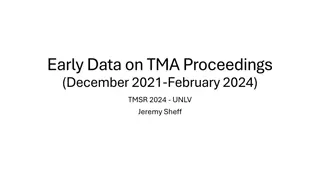

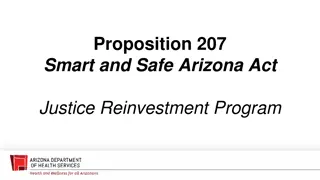
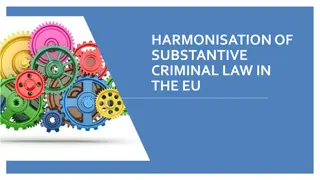
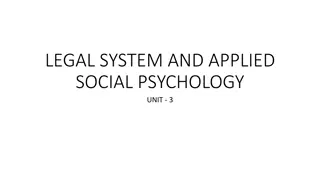

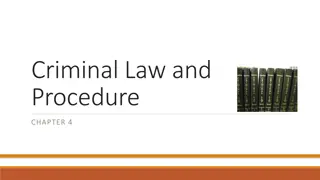
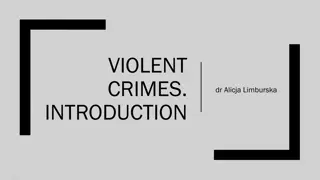
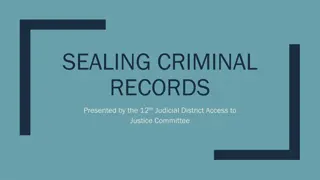
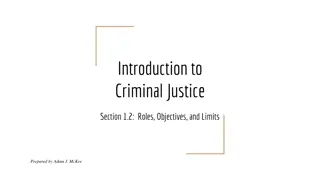
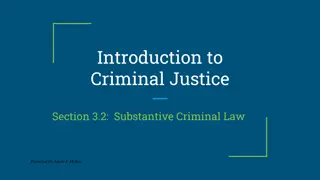
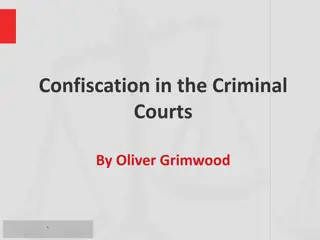

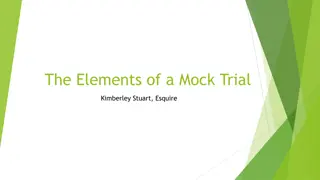
![Briefing on the Criminal Procedure Amendment Bill [B12-2021] to the Portfolio Committee on Justice and Correctional Services](/thumb/157093/briefing-on-the-criminal-procedure-amendment-bill-b12-2021-to-the-portfolio-committee-on-justice-and-correctional-services.jpg)
